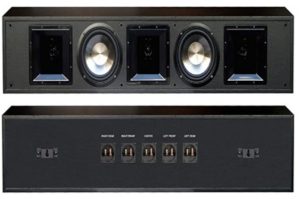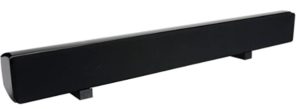What is the difference between passive and powered soundbars?
The main difference between the two is how they drive their speakers.
Active soundbar
An active soundbar has a built-in amplifier and audio decoder to allow it to process input, amplify it, and drive speakers on its own.
Passive soundbar
A passive soundbar does not have a built-in amplifier meaning you will need additional amplifiers or receivers to work properly. This means it cannot process video and audio information and requires a connection to a central preacher. It can also be used as part of a home theatre system.
Who needs a passive soundbar?
A passive soundbar is an excellent option for several reasons. Below are some cases where you would be better off going for a passive soundbar instead of an active one. That said, here are the best passive soundbars in the market currently.
Top 4 Passive Soundbars
KEF HTF7003 Sound Bar Speaker Black
This soundbar is designed to complement today’s stylish flat-panel televisions. It has a very thin profile designed to match the depth of most flat-panel televisions. It features a stylish aluminum enclosure that contains dual 2-Inch woofers and a 19mm HF driver. The soundbar comes with a wall mount bracket and a table stand. The soundbar is made from extremely durable material, and it has a high gloss black finish. Features
Dual 2-Inch woofers19mm HF driverHigh gloss black finishDesign: Two-Way bass reflexSensitivity (2.83V/1m): 85dBFrequency Response (+/-3dB): 120Hz – 22kHzImpedance: 8ΩPower Handling: 100WDimensions (H x W x D): 3.1 x 30.9 x 2.4 in.Finishes: High gloss blackMax SPL: 106dBGold Plated TerminalsWall Mount or Table Stand
Pros
Thin profileHigh qualityCompact size
Cons
Works best when paired with a central speaker
BIC America Patented 625-Watt FH56-BAR Sound Bar
The BIC Patented soundbar system features 3 or 5 discrete channels and plays True 5-channel theater sound. It has three 6.5-inch mid-high frequency horn tweeters with neodymium magnets that deliver highs beyond the audible range and extremely accurate mid frequencies. It also has two 6.5-inch injection-molded woofers with butyl-rubber surroundings that produce extended bass output down to 37 Hz. And two 4.25-inch side-mounted surrounds for true rear channel effects. Check this too: Best Vertical Soundbar Its patented technology enables single drivers to reproduce multiple channels while combining with other drivers to create a true lifelike expanded soundstage. Features
Speaker Type: Center Channel, SubwooferItem Weight: 35 PoundsSurround Sound Channel Configuration: 5Mounting Type: Wall MountThree horn tweetersTwo injection-molded woofersTwo side-mounted surrounds
Pros
Precise, focused soundExtremely accurate mid frequencies.Extended bass output
Cons
Not compatible with some TVs
Klipsch G-42 Passive Soundbar
The Klipsch passive soundbar provides a cross-over home audio solution with left, right, and center channel speakers contained in one sleek cabinet. It produces accurate, non-fatiguing sound for the ultimate music listening experience. It is equipped with horn-loaded technology in an extremely thin speaker. And it features three dynamic 1″ tweeters for the left, right, and center channels. And four 3.5″ high-output woofers; one for the left and right channels and two for the center channel. Features
Item Weight: 12 PoundsHorn-loaded technologyDynamic 1″ tweeters
Pros
Cross-over home audio solutionNon-fatiguing soundSleek design
Cons
It needs to be paired with a powerful sub-woofer
Dayton Audio BS36 36″ LCR Speaker Bar Black
The Dayton soundbar features three 3-3/4″ paper cone woofers and three 5/8″ aluminum tweeters. Additionally, the beautiful hand-rubbed black lacquer finish makes it a perfect décor item while still producing high definition sound. Check this too: Why Won’t My Soundbar Work with My TV The soundbar is ideal for space-limited home theater applications. It can connect to any home theater receiver via separate left, right, and center speaker inputs. You can also position it on any flat surface or mounts it on a wall. It is easy to install, and it comes with a pair of rubber speaker feet for tabletop mounting. Features
Three 3-3/4″ paper cone woofersThree 5/8″ aluminum tweetersImpedance: 8 ohmsFrequency response: 100-20,000 HzDimensions: 4-3/4″ H x 36″ W x 4-1/4″ D
Pros
Ideal for limited spacesHigh-gloss black lacquer finishEasy to install
Cons
Poor bass sound output
Conclusion
The best passive soundbar should be easy to use, space-efficient, and energy-efficient. It should also produce good quality sound and be compatible with multiple smart devices, audio, and video devices. Look for a passive soundbar that can work with wired and wireless connections for ease of use when connecting it to other speakers. Lastly, ensure the passive speaker can accept larger drivers if you intend to use it for a custom speaker system.



